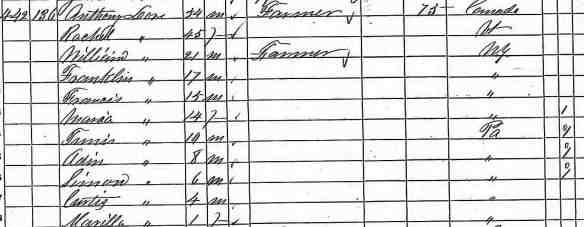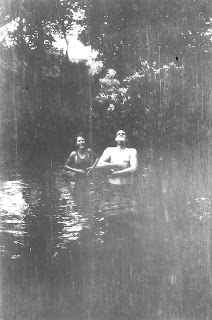Grandma Potter's great-grandfather Antoine Lore was born after his parents, Honore' Lore and Marie LeFaille, had emigrated to Quebec from New York/Massachusetts after the British lifted their ban on the Acadians. Their home was near the parish of Blairfindie, in what would become the town of l'Acadie.
 |
| Ste-Marguerite-de-Blairfindie credit: Histoire de L’Acadie, Provence de Quebec, published in 1908 via Roberta Estes |
 |
| Batismal Record of Antoine Lore, 1805 Ste-Marguerite-de-Blairfindie church credit: Roberta Estes |
In 1831, at the age of about 25, he marries a Vermont girl, Rachel Hill, who is at most 15 or 16, having been born in 1815. The marriage was by a Justice of the Peace, with no other information filled in. Rachel's family is an old-time New England family with Mayflower ancestors and almost certainly Protestant. Perhaps an elopement with an exotic and handsome older man?The 25th of March 1805, we the undersigned have baptized Antoine, born yesterday of the legitimate marriage of Honoré Lord, joiner, and of Marie Lafay of this parish. The godfather was Antoine Crotteau and godmother was Rosalie Guerin, who (both) declared they did not know how to write. The father has signed with us.
s/ Honoré Lore (sic) s/ R. P. (Rev. Père) Lancto, Priest
Vermont is in easy reach of l'Acadie, traveling south up the Richelieu River to Lake Champlain and then a few miles east to Bristol and Starksboro. Antoine was perhaps already an itinerant trader, as he would be later in life.
 |
| Birth Record Rachel Levina Hill credit: Roberta Estes |
 |
| Marriage Record, 1831 Antione Lore and Rachel Hill credit: Roberta Estes |
There is no sign of Antoine and Rachel's whereabouts until 1843 where, according to Franklin Lore's descendants, Frank was born in Jamestown, Chautauqua County, New York. There are, however, no official records to support this tradition. William Lore was born earlier, in 1839, also in New York, probably in the same general area.
It is not probable that there were not other babies born between 1831 and 1839; they most likely died in infancy. More died later.
Antoine (now "Anthony") and Rachel appear in the 1850 and 1860 census in Warren County, Pennsylvania, which is just down the Allegheny watershed from Jamestown, New York. "Anthony" applied for US citizenship on June 2, 1862 in Warren County. With a five-year waiting period before his final application, "Anthony" should have reappeared in 1867. He does not, though, and so is presumed dead 1862-1867. Rachel is gone shortly after the 1870 census. She left a number of younger children, who were taken in by relatives or hired out as farm labor.
Several of the families who descended from Antoine Lore had stories about him and about his death. He likely spent much of his life as an "Indian trader" or "River Pirate" on the Allegheny River. Roberta Estes' source for the "River Pirate" tale lived in Indiana yet used the local Allegheny River term and was embarrassed by the whole issue; this gives me some confidence in the story. Allegheny river pirates were not pirates as such, but traders who supplied raftsmen on the river with beverages and other goods, mostly of inferior quality at untaxed prices.
The different family stories tend to agree that Antoine drowned, most likely in the Allegheny, possibly in the line of his duties, and probably murdered. A capsized raft figures in one story.
 |
| "The Progenitor" possibly Antoine Lore (1805-before 1867), more likely his son Frank (1843-1916) credit: Frank Lore Family, via Roberta Estes |
 |
| Curtis B. Lore (1861-1909) photo ca. 1887 (aged 26 years) William H. Lore's Brother credit: Roberta Estes |











































